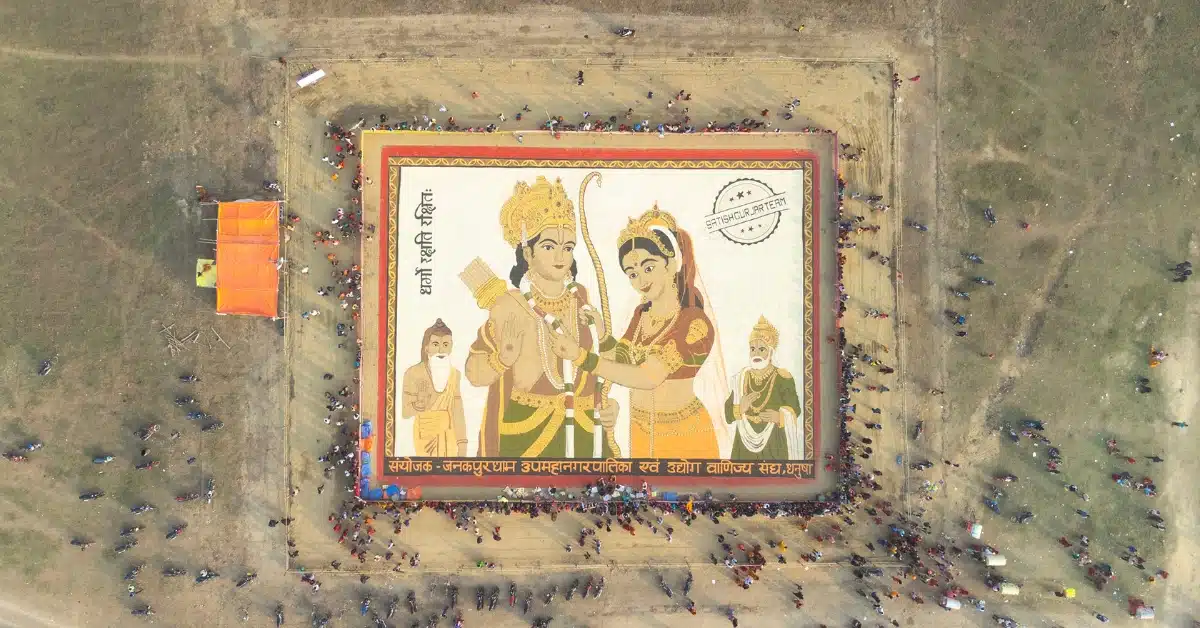Newswrap:
Location: Janakpurdham

Creation of Idol: Commenced on Sunday, using 11 types of grains including rice, wheat, chickpeas, maize, black gram, and lentils.
Artist: Renowned sculptor Satiś Gurjar leading an eight-member team.
Previous Work: Satiś Gurjar previously created a grain-based idol of Sita-Ram in Ayodhya, registering his name in the World Harvard Book of Records.
Introduction
In the heart of Janakpur Dham, Nepal, an extraordinary celebration unfolded during Vivah Panchami, marking the union of Lord Rama and Sita. The town witnessed the creation of a jaw-dropping artwork spanning 121 feet in length and 91 feet in width, depicting the divine couple Sita-Ram. Crafted from 101 quintals of 11 different grains, this masterpiece stands as a testament to the skill and dedication of artisan Satish Gurjar and his eight-member team from Madhya Pradesh’s Harda district.
Background:
Initiator: Mayor Manoj Kumar Sah initiated the auspicious project in Janakpurdham.
Land Area: The idol will be built on an 11,011 square feet plot.
Completion Date: Scheduled to be completed by December 12, as confirmed by sculptor Satiś Gurjar.
Inauguration:
Inaugurator: Mayor Manoj Kumar Sah officially inaugurated the construction in Janakpurdham.
Artistic Input: Satiś Gurjar, hailing from Kokrabat village in Madhya Pradesh, has a history of creating such idols. He previously crafted a 10,800 square feet idol in Ayodhya.
Composition of Idol:
Grain Quantity: The idol will incorporate 101 quintals of grains.
Monetary Value: The grains, along with light, sound, and promotional expenses, are estimated to cost approximately ₹1,268,000.
Team Collaboration: Satiś Gurjar’s team from Kokrabat village in Harda district, Madhya Pradesh, collaborates to create this masterpiece.
Celebration and Record:
Recognition: Satiś Gurjar’s previous work in Ayodhya has been recorded in the World Harvard Book of Records.
Community Involvement: The Janakpurdham project involves the participation of the local community, contributing to the creation of a divine idol.
Significance of the Artwork
Diverse Grains: Utilizing 11 different grains, including rice, wheat, and chickpeas, the artwork symbolizes agricultural diversity and unity. Each grain contributes to the intricate details, creating a feast for the eyes and a nod to the rich tapestry of agriculture.
Devotees’ Experience
Spiritual Pilgrimage: Devotees attending the divine marriage ceremony find themselves mesmerized by this colossal artwork. Its size and attention to detail elevate the spiritual experience, prompting some to wonder if they accidentally stepped into a grain-based wonderland.
Preparation for the Wedding Celebration
Grandeur at Janaki Temple: While the colossal artwork steals the spotlight, the Janaki Temple is not to be outdone. The temple, dedicated to Goddess Sita, has undergone lavish adornment in preparation for the grand celebration of Sita and Ram’s divine union.
Financial Aspect:
Estimated Cost: The overall expenditure, including grains and additional expenses, is anticipated to be ₹2,123,000.
Funding Source: The financial estimate is based on the information provided by Hindustan newspaper.
FAQs:
What types of grains are being used in crafting the idol?
Who is the sculptor leading the project?
How much land is allocated for the construction of the idol?
When is the scheduled completion date for the idol?
What is the estimated cost of the project, including grains and other expenses?
What grains were used in the creation of the artwork?
How much did the construction of the artwork cost?
What will happen to the grains after the Vivah Panchami celebrations?
Why was this painting created from grains?
Who led the team responsible for creating the painting?
What are the dimensions of the Lord Sita-Ram painting?
Unveiling the Grainy Tale in Janakpurdham
The quaint town of Janakpurdham, known for its historical and cultural significance, is now embarking on an extraordinary journey – the crafting of Lord Sitaram’s idol using an unusual palette of grains. It’s a tale that began with the visionary Mayor Manoj Kumar Sah, who planted the seed of this unique project, and now it’s sprouting into a masterpiece under the skilled hands of sculptor Satiś Gurjar and his team.
Sowing the Seeds of Creation
The creation of the idol kicked off on a Sunday, with the ground breaking ceremony witnessing the use of 11 different types of grains. From the familiar rice and wheat to the more exotic chickpeas, maize, black gram, and lentils – it’s a grain buffet fit for the gods. Imagine Lord Sitaram standing tall, constructed not just with devotion but with a pinch of culinary diversity!
The Maestro Behind the Magic
Leading this grainy endeavor is none other than the seasoned sculptor, Satiś Gurjar. Hailing from Kokrabat village in Madhya Pradesh, Gurjar has already etched his name in the World Harvard Book of Records with a previous grain-based idol in Ayodhya. Now, he’s all set to weave his magic in Janakpurdham, infusing life into the grains and bringing divinity to the heart of the town.

From Ayodhya to Janakpurdham
Satiś Gurjar is no stranger to the art of grain-based idol making. His previous work in Ayodhya, a colossal 10,800 square feet idol of Sita-Ram, stands as a testament to his artistic prowess. Now, Janakpurdham is the canvas for his next creation, promising to be even more grandiose at 11,011 square feet. It seems Gurjar is on a mission to outdo his own records – literally!
A Grainy Affair with the Community
This isn’t just a one-man show. The Janakpurdham project is a celebration of community spirit. The local residents are actively participating, contributing not just financially but also lending a helping hand in the actual crafting process. It’s a communal feast for the senses, where every grain adds a pinch of unity to the concoction.
Symbolism and Cultural Significance
Harmony in Diversity
The grains aren’t just there for show. They symbolize the unity in the agricultural landscape, much like a potluck dinner where every dish brings something unique to the table. It’s like saying, “Let’s make art, not war.”
Community Participation and Celebration
A Community Affair in Janakpurdham
This wasn’t just an artist’s gig; it was a community shindig. Locals joined in, turning it into a cultural flash mob. It’s the kind of participation that makes you wish your birthday party was this cool.
The Grainy Composition: Rice, Wheat, and a Dash of Chickpeas
Now, let’s delve into the nitty-gritty of the idol’s composition. The choice of grains is as diverse as the community that worships the divine figures it represents. Here’s a breakdown of the key components:
- Rice: The staple of many households, rice forms the base of the idol, providing a sturdy foundation.
- Wheat: Symbolizing fertility and abundance, wheat adds a touch of prosperity to Lord Sitaram’s countenance.
- Chickpeas: Ah, the humble chickpea – a protein powerhouse and a nod to the nutrition-conscious divinity. After all, even gods need their dose of protein!
- Maize: Bringing a burst of color and texture, maize kernels weave a vibrant tapestry into the idol’s form.
- Black Gram: Known for its rich flavor, black gram represents the depth of devotion the community pours into this project.
- Lentils: Tiny but potent, lentils symbolize the strength that comes from unity, each lentil contributing to the greater whole.
And there are six more varieties, each adding its unique flavor to the divine mix. It’s like a culinary symphony, where the grains dance in harmony, creating not just an idol but a feast for the eyes.
The Finances: More Than Just Loose Change
Crafting a masterpiece, especially one that involves 101 quintals of grains, doesn’t come cheap. Let’s take a look at the financial aspect, a realm where even divine endeavors have a price tag.
The Estimated Cost
The overall expenditure for this grainy spectacle is estimated to be around ₹2,123,000. This includes the cost of the grains, as well as expenses for lights, sounds, and promotional activities. It’s a budget that rivals Hollywood productions, but in this case,

